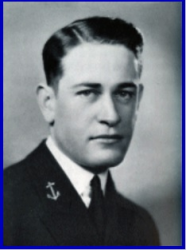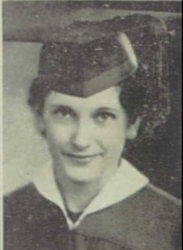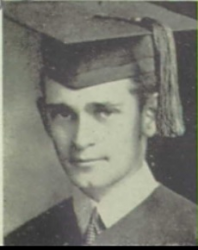
 |
|
|
||
|
PAUL JAMES RILEY 'Pat' |
||||
|
Graduate, U.S. Naval Academy, Class of 1937 Engagements: • World War II (1941 - 1945) |
||||
| Biography: | ||||
|
Paul James Riley Lieutenant, United States Navy Navy Cross
Paul was the son of Jason Daniel Riley "JD" and Elizabeth "Lizzie" Nealie Williams who were married on 19 April 1908 in Garland county, Arkansas. Paul's siblings included Mildred Laverne, James Whitcomb, and Sarah Edith Riley. Paul and James served in the Armed Forces during WWII. Paul, James and Sarah graduated from Hot Springs High School. ----------------------------------- After obtaining his father's permission to join the US military, Paul enlisted in the Naval Reserve 12 Dec 1931 as an Apprentice Seaman (A.S.). Several years later, he received a nomination from Arkansas to the Naval Academy and entered on 26 Jun 1933. Four years later he graduated with the USNA class on 03 Jun 1937, and was commissioned an Ensign, USN. While at the Academy he was known as "Pat" "Commodore," "Alice," and "Pablo." His classmates wrote this about him in the 1937 edition of the Lucky Bag yearbook; "When Pablo decided with characteristic deliberations to leave the Ozarks for the land of big guns and red tape, he was as good as here. He has the foresight and determination to carry out any plans he makes. Rarely ruffled, he is enough of a stoic to take the grind without kicking, enough of an idealist to say, 'It won't be like this a year from now.' His companionship, like the proverbial wine, grows better with age. It is of lasting value because it is tempered with a sufficiently serious mind and spiced with a genuine Irish humor." He began his mandatory sea duty tour on 29 June 1937 on board the aircraft carrier USS Saratoga (CV-3). He detached from USS Saratoga in June 1939 and began (heavier-than-air) flight training under instruction at Naval Air Station (NAS), Pensacola later that month. He was temporarily transferred to NAS Miami in the early Spring of 1940 for advanced training for pilots who had orders to carrier based squadrons. He completed his flight training under instruction and was designated a naval aviator 22 May 1940. He was promoted on 03 Jun 1940 to Lieutenant Junior Grade (Ltjg.). Later that month he detached from NAS Pensacola with orders to report to Torpedo Squadron Six (VT-6) for duty. He reported for temporary duty to the 11th Naval District in San Diego, CA while awaiting transportation to Pearl Harbor. The following month, on 22 July 1940, Ltjg Riley boarded the USS Neosho (AO-23), a Cimarron-class fleet oiler, as a passenger in San Diego, CA for further transfer (FFT) to the USS Enterprise (CV-6). On 28 July, he reported for duty with VT-6 on board the aircraft carrier USS Enterprise (CV-6). He was promoted to Lieutenant on 6 Jan 1942. The Enterprise was commissioned on 12 May 1938. Torpedo Squadron Six (VT-6) was commissioned on 01 July 1938. During 1938-1939, Enterprise and her embarked squadrons conducted shake down cruises and workup exercises at various times. While the ship was inport the squadrons were temporarily based ashore at their assigned airfields. In Sep 1939, Enterprise became part of the Hawaiian Detachment of the U.S. Fleet whose homeport was Pearl Harbor. In Jan 1940 Enterprise was engaged in exercises in Hawaiian waters. In early Feb, she steamed for Puget Sound Navy Shipyard for an overhaul after making a brief port call in San Diego. In late May, Enterprise, her overhaul completed, returned to San Diego for about a month. She returned to Pearl Harbor on 2 July 1940. Enterprise conducted exercises from August to early Nov in the Hawaiian area. Then on 09 Nov she steamed to San Diego until 2 Dec when she got underway for the Puget Sound Navy Shipyard in Bremerton, WA. Enterprise returned to Pearl Harbor on 21 Jan 1941. During 1941 Enterprise made 13 round trips between Hawaii and San Diego from April - Nov conducting exercise cycles and squadron work-ups. During those months she also shuttled Army Air Force P-39s and P-40s, as well as, Navy aircraft from US West Coast ports to Pearl Harbor and beyond. On 28 Nov 1941, Enterprise, now operating in a war-time steaming condition, left San Diego with a cargo of Marine Fighting Squadron 211 (VMF-211) aircraft and pilots destined for Wake Island. The Marine pilots and their planes flew from Enterprise to Wake Island on 02 Dec 1941. Enterprise was scheduled to arrive back in Pearl Harbor on 06 Dec, but was delayed due to inclement weather. Fortunately, she wasn't inport on the morning of 07 Dec, but arrived later that evening. In the first five months of 1942, Enterprise and her Air Group participated in the attack on Gilbert and Marshall Islands on 01 Feb 1942. During this action VT-6 attacked enemy Japanese forces on Kwajalein. Lt Riley was awarded the Distinguished Flying Cross for his actions against enemy Japanese forces on the Marshall Island group. Enterprise also participated in the Wake Island raid 24 Feb 1942. On 4 March, Enterprise’s Air Group attacked enemy installations on the Marcus Islands and on 18 April, she supported the Doolittle raid. In early May, Enterprise and the aircraft carrier USS Hornet (CV-8) were dispatched to the South Pacific to assist the aircraft carriers USS Lexington (CV-2) and USS Yorktown (CV-5) who were engaged in the battle of the Coral Sea. However, before the ships arrived on-scene the battle of the Coral Sea was over. After participating in additional operations in the Central Pacific, Enterprise returned to Pearl Harbor on 26 May and began intensive preparations to meet an expected Japanese thrust at Midway Island. Enterprise got underway from Pearl Harbor on 28 May 1942, and with USS Hornet (CV-8), steamed toward a point Northeast of Midway called "Point Luck." USS Yorktown (CV-5) followed a short time later ----------------------------- Early on the morning of 4 Jun 1942, pilot Lt Riley and his radioman-gunner ARM2 Edwin John Mushinski launched their torpedo plane from Enterprise along with other members of VT-6 and Air Group Six to attack the Japanese striking force that was near Midway. Separated from their covering fighter protection, VT-6, comprised of 14 torpedo planes, pressed their attack even though overwhelmed by superior numbers of Japanese fighter aircraft. One by one the planes of VT-6 were shot down. Of the 14 planes only four returned to Enterprise. Lt Riley and Petty Officer Mushinski did not return. According to the USS Enterprise Battle of Midway after action report dated 8 Jun 1942, Lt Riley and ARM2 Mushinski were recorded as personnel losses in battle. Their remains were unrecoverable. They were missing in action on 04 Jun 1942 and presumed dead on 5 Jun 1943. In addition to the Distinguished Flying Cross, Lt Riley was also awarded (posthumously) the Navy Cross, The Purple Heart, the Presidential Unit Citation ribbon, American Defense Service Medal, Asiatic-Pacific Campaign Medal with one bronze star, and the World War II Victory Medal. ---------------------------------- Of the 14 Torpedo Bombers from VT-6 that flew against the Japanese on 4 Jan 1942 only four returned to Enterprise. Enlisted pilot Machinist Albert Walter Winchell (NAP), and his gunner, Aviation Radioman 3rd Class Douglas M. Cossitt, made a water landing before sighting Enterprise. They survived 17 days on the open seas in a rubber raft before being rescued by a Patrol Squadron 24 PBY on 21 Jun 1942, some 360 miles northward of Midway. In all, five VT-6 crews survived the morning attack. ------------------------------------- The pilots and crew of VT-6 that were killed in action on 04 June 1942: 1) Lcdr Eugene Elbert Lindsey (CO VT-6) and his gunner, ACRM Charles Tilden Grenat. 2) Lt Arthur Vincent Ely (VT-6 XO) and his gunner, RM3 Arthur Richard Lindgren 3) Lt Paul James Riley and his gunner, ARM2 Edwin John Mushinski 4) Ltjg John Thomas Eversole and his gunner, RM2 John Udell Lane 5) Ltjg Randolph Mitchell Holder and his gunner, ARM3 Gregory Joseph Durawa 6) Ltjg Severin Louis Rombach and his gunner, ARM2 Wilburn Forrest Glenn 7) Ltjg Lloyd Thomas and his gunner, ARM2 Harold Francis Littlefield 8) Ensign John Wiley Brock and his gunner, ARM3 John Melville Blundell 9) Ensign Flourenoy Glenn Hodges and his gunner, RM2 John Hail Bates --------------------------- Combat Action Ribbon (CR) note: None of the Navy/Marine flight crews in the Battle of Midway were eligible for or were awarded the Combat Action Ribbon (CR). See Navy and Marine Corps Awards Manual (SECNAVINST 1650.1H of Aug 22, 2006, Chapter 2, Section 3, p2-34). It reads in part, “The CR will not be awarded to personnel for Aerial Combat, . . . “ The CR was established in 1969 and made retroactive to 07 Dec 1941. ----------------------------------- The Navy Cross citation reads: The President of the United States of America takes pride in presenting the Navy Cross (Posthumously) to Lieutenant Paul James Riley , United States Navy, for extraordinary heroism and courageous devotion to duty while piloting an airplane of Torpedo Squadron SIX, in action against enemy Japanese forces in the Battle of Midway on 04 June 1942. Participating in a vigorous and intensive assault against the Japanese invasion fleet, Lieutenant Riley pressed home his attack with relentless determination in the face of a terrific barrage of anti-aircraft fire. The unprecedented conditions under which his squadron launched its offensive were so exceptional that it is highly improbable the occasion may ever recur where other pilots of the service will be called upon to demonstrate an equal degree of gallantry and fortitude. His extreme disregard of personal safety contributed materially to the success of our forces and his loyal conduct was in keeping with the highest traditions of the United States Naval Service. He gallantly gave his life for his country. General Orders: Bureau of Naval Personnel Information Bulletin No. 309 (December 1942) -------------------------------- Lt Riley's Distinguished Flying Cross citation reads: The President of the United States of America takes pride in presenting the Distinguished Flying Cross (Posthumously) to Lieutenant Paul James Riley, United States Navy, for heroism and extraordinary achievement while participating in aerial flight during the operations of United States forces against Marshall Islands on 1 February 1942. With utter disregard for his own safety, despite intense and sustained enemy anti-aircraft fire. Lieutenant Riley developed the attack of the section he was leading against an enemy light cruiser in a most efficient and tenacious manner, which resulted in the destruction of an enemy ship. General Orders: Bureau of Naval Personnel Information Bulletin No. 304 (July 1942) ------------------------------ The Presidential Unit Citation was present to the Enterprise crew and members of its embarked Air Wing Six. The citation reads: For consistently outstanding performance and distinguished achievement during repeated action against enemy Japanese forces in the Pacific war area, 7 December 1941, to 15 November 1942. Participating in nearly every major carrier engagement in the first year of the war, the Enterprise and her air group, exclusive of far-flung destruction of hostile shore installations throughout the battle area, did sink or damage on her own a total of 35 Japanese vessels and shot down a total of 185 Japanese aircraft. Her aggressive spirit and superb combat efficiency are fitting tribute to the officers and men who so gallantly established her as an ahead bulwark in the defense of the American nation. ------------------------------ His family also received a commemoration from President Franklin D. Roosevelt. It reads: In grateful memory of Paul James Riley, who died in the service of his country, SEA, Pacific Area, ATTACHED U.S.S. ENTERPRISE, 5 JUNE 1943 (Presumed)*. He stands in the unbroken line of patriots who have dared to die that freedom might live and grow and increase its blessings. Freedom lives, and through it, he lives -- in a way that humbles the undertakings of most men. (Signed) Franklin D. Roosevelt, President of the United States of America ------------------------------ The USS Riley (DE-579) was named in his honor. Riley was laid down 20 October 1943 by Bethlehem-Hingham Shipyard, Inc., Hingham, Massachusetts. She was launched and christened on 29 Dec 1943 by his sister, Miss Mildred Laverne Riley. She was commissioned on 13 March 1944. Riley conducted convoy escort duties in the Atlantic and Mediterranean areas. She saw combat action on 12 July 1944 when she fought off a German aerial attack. On 3 Nov 1944 Riley steamed to the Pacific via the Panama Canal anchoring in Humbolt Bay on 11 Dec 1944. Riley conducted escort duties in and around the Philippines until 07 July 1945 when she escorted a convoy to Okinawa. After the cessation of hostilities more escort tasking to Okinawa. After the formal surrender, she escorted two occupation troop convoys to Jinsen, Korea. In mid-Oct Riley steamed for the United States via Pearl Harbor. She reached San Diego on 05 Nov and was assigned to the Pacific Reserve Fleet. On 15 Jan 1947, she was decommissioned at San Diego, CA. She earned two battle stars during WWII. Transferred to Taiwan in 1968. ----------------------------- Task Force 16 Citation Recognizing its contribution to the Doolittle Raid, 18 April 1942 On the occasion of the 50th anniversary of the Second World War, it is appropriate that we take time to reflect on the unique and daring accomplishments achieved early in the war by Task Force 16. Sailing westward under sealed orders in April 1942, only four months after the devastating raid on Pearl Harbor, Task Force 16, carrying sixteen Army B-25 bombers, proceeded into history. Facing adverse weather and under constant threat of discovery before bombers could be launched to strike the Japanese homeland, the crews of the ships and LTC Doolittle's bombers persevered. On 18 April 1942 at 14:45, perseverance produced success as radio broadcasts from Japan confirmed the success of the raids. These raids were an enormous boost to the morale of the American people in those early and dark days of the war and a harbinger of the future for the Japanese High Command that had so foolishly awakened "The Sleeping Giant." These exploits, which so inspired the service men and women and the nation live on today and are remembered when the necessity of success against all odds is required. (Signed) John H.Dalton Secretary of the Navy 15 May 1995
------------------------------ [Bio compiled by GML470] |
||||
| Honoree ID: 100699 | Created by: MHOH | |||
Ribbons
Medals
Badges
Honoree Photos
 |  |  |
 |  |
 |


